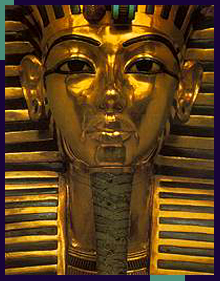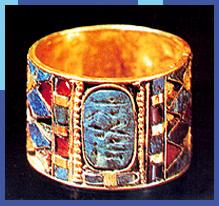 Tutankhamun's sarcophagus
Tutankhamun's sarcophagus |
The
story of the discovery of the tomb of this Pharaoh who died
when he was barely eighteen years old is too long, too fascinating
and too mysterious to be told in its entirety here. It was
discovered on 4th November 1922 by Howard Carter (acting on
behalf of Lord Carnarvon) and it made history because of the
enormous amount of treasures found in the burial chamber which,
fortunately had remained untouched by grave robbers. It is
still worthwhile to read Carter's own account of this historic
discovery, in order to relive day by day, moment by moment
its various phases.
Unlike
its contents the tomb itself was very modest, perhaps because
it was built in great haste as a result of the unexpected
death of the king. Inside, among all the funeral trimmings
the thing which stands out because of its great beauty is
the Pharaoh's sarcophagus. It is more correct to say the sarcophagi
since the royal corpse was contained in three mummy cases;
the first of gilded wood, the second also of gilded wood but
with the addition of a powdered glass paste, while the third
is of solid gold.
"The
golden sarcophagus is one of the greatest masterpieces of
the goldsmiths' art of all time; it contains two hundered
kg of gold, is one and half meters high and is encrusted with
lapis lazzuli, turquoise and cornelians."
|

|
Romantic
gesture and curses
However,
among all this glitter, the thing, which made the greatest
impression on Carter and his party, was a little wreath of
dried up flowers, a last pathetic gesture from the consort
of the boy pharaoh. Finally, let us not forget that in addition
to the already romantic story of the discovery itself there
is that obscure business that later came to be known as "the
Pharaoh's curse".
The
sudden violent deaths of the majority of those who took part
in Lord Carnarvon's expedition, with the exception, strange
to say, of Carter himself, lent strength to the belief in
a posthumous vendetta by the dead Pharaoh whose eternal sleep
had been disturbed.
History
of course is full of such legends and this one only adds to
the fascination of the already fascinating romance of Tutankhamun.
Exhibition
The
story of the discovery of the young Pharaoh's tomb, whose
marvelous treasures today fill a quarter of the Egyptian Museum,
is well known.
 Braclet found in the tomb
Braclet found in the tomb |
All
the royal tombs in the Valley of the Kings were robbed except
that of Tutankhamun, which is the only one to have been discovered
intact. Because he died at an early age, nineteen, his tomb
might have been passed over as not containing enough treasures
for the tomb robbers to bother with. In spite of other new
discoveries, King Tut will always remain a symbol of Egypt's
ancient civilisation in the eyes of the world.
|
|